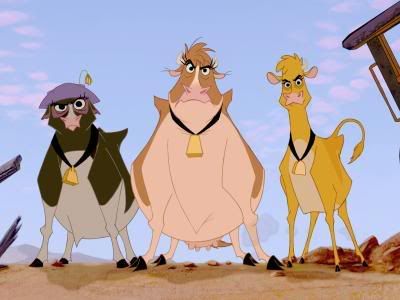
Maybe it is like some critics say. Creativity, like national power, hits a peak and then inevitably declines, never to hit the magical summit again. Roger Moore (the movie and book critic, not the former James Bond) maintains that just such a scenario is now happening at Disney's new animation studio:
... Pixar has ramped up production to the point where they're doing the same thing Disney Feature Animation did before the bottom fell out-- a film a year, whether everything is ready (story-wise, casting, etc.) or not. The implication that Pixar is the gold standard and will always be seems short-sighted. They need Wall-E to hit. Not as badly as Dreamworks needs a blockbuster outside of the Shrek franchise, but they do need big Wall-E numbers ...
Uh, it really isn't because you do one movie a year ... or two ... or five. It's how many good movies you make.
See, I was stumbling around Disney's when they were hitting on all cylinders ... and also when the bottom fell out ... and here's at least some of the reasons everything went south (none having to do with numbers of films):
They started making the same feature, over and over. There's only so many times you can make the Animated Broadway musical before the public starts to lose interest, muttering to itself: "Haven't we seen this already?"
(In the teaching business -- which I was in for a time -- wise older teachers told stupid younger teachers: "Sure you've got a great lesson plan. But you can't go on using it forever. Sooner or later the kids get bored with it and tune out." This also happens with Hollywood films.)
They built empires. When I left Disney in 1986, there were three production people serving an animation staff of 160 artists. By the late 1990s, there were almost as many production managers, production coordinators, production assistants and junior and senior vice-presidents as creatives. At one point there were somewhere around 26 animation vice-presidents, and that was about 25 too many. Because what that bureaucracy did was make lots of bureaucratic work for itself, with the nasty side effect of gumming up the works creatively.
(A storyboard artist once told me: I've got to go to the scheduling person to get on the master calendar for a meeting with the director. They send me an e-mail giving me the time and date." My face fell atop the floor.)
Management started second and third-guessing every decision. Disney veeps would greenlight a picture, change their mind, restart a picture. They would hire a director, then fire him. They would hire two directors. Some features were in work six or seven years, reworked dozens of times. (Home on the Range is a vivid example of this "do and redo" mentality.)
I could go on, but you get the idea. When a place becomes top-heavy with paper pushers who don't add any creative oomph to the enterprise, but lots of red tape that slows the business of making pictures to an ineffective crawl, it is well and truly over.
But "doing one picture a year"? That really isn't the issue.
And it isn't for Pixar. The dangers for the boys and girls at the Emeryville studio aren't the numbers of productions, but rather: Can they avoid repeating shtick? Will they wade clear of bureaucratic quicksand? Will the creative juices keep flowing?
Nobody hits a home run everytime they step to the plate, and Pixar won't either. The public is often fickle and always changeable. But accelerating production to one picture a year won't kill the Golden Desk Lamp.
Those other things will.




7 comments:
Here is a short interview with Brad Bird where he discusses most of the points you just brought up:
http://tinyurl.com/682wfh
Now you know why artists at Disney TV Animation are reluctant to really give it their all in the product. There's so much interference from up top that a lot of what you worked on is likely to get revised, so why put your best effort into anything when some suit is likely to throw it in the garbage?
Now you know why artists at Disney TV Animation are reluctant to really give it their all in the product.
Actually I've known for years. And it's always been stifling for artists, hired to do a job, to get smothered by layers of notes from execs in the Alameda tower.
But look at it from the execs POV: They're in a position to "supervise", so they do. If they don't give lots of notes, some higher-up will say: "What am I paying you for?"
Is it me or does Roger Moore always write about Pixar like he's got something against them?
" If they don't give lots of notes, some higher-up will say: "What am I paying you for?"
Good question !
In that Brad Bird interview referenced above , he says:
Brad Bird: "In my experience, the thing that has the most significant impact on a movie’s budget—but never shows up in a budget—is morale. If you have low morale, for every $1 you spend, you get about 25 cents of value. If you have high morale, for every $1 you spend, you get about $3 of value. Companies should pay much more attention to morale."
And, that's the reason hospital administrators don't do open heart surgery.
If you're not an expert, stay in your office, collect your bloated paycheck and keep your (blankety blank) mouth shut.
Couldn't agree more. Thanks for sharing!
Post a Comment